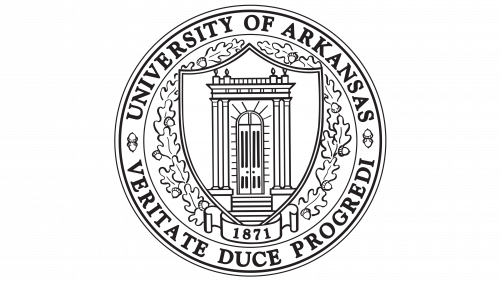 University of Arkansas Logo PNG
University of Arkansas Logo PNG
The University of Arkansas logo could not be simpler, reflecting the university’s high achievements in science and education. From the moment the university was established, it was entrusted with an important mission—to convey its main focus areas, highlight universally accepted traditions, and always be associated with the University of Arkansas. Therefore, the modern logo, like its predecessor, stands out for its elegance, informativeness, and unique style.
The identity of this logo is a harmonious combination of graphics and geometry, where unity and contrast create an impressive visual impact. The texts and images, presented in an unconventional format, produce a special visual effect, enhanced by a thoughtful color scheme that helps to emphasize key elements in the intended order, following the designers’ concepts.
The logo’s textual element is placed beneath the graphic image, creating a balanced composition. A ribbon with the founding date is a connecting element, underscoring the university’s historical significance as one of America’s first public educational institutions.
University of Arkansas: Brand overview
The establishment of the University of Arkansas dates back to 1871 when the Arkansas General Assembly approved a bill to create an industrial institution. The Morrill Act, which gave states access to federal property for establishing agricultural and mechanical arts-focused educational institutions, was the basis for this decision.
The institution was first established in the city of Fayetteville, which is still located today. The local community made a substantial offer to provide land and money for the institution’s construction, which is why the location was selected. On January 22, 1872, the university’s first classes were held. There were just eight pupils enrolled in the first year, along with one instructor. Built-in 1875, the earliest structure, dubbed “Old Main,” still represents the university.
The school became one of the first public universities in the South to admit women when it opened its doors in 1887. This choice greatly enhanced enrollment and broadened the area’s educational options.
The institution experienced substantial growth in the late 19th and early 20th centuries. The founding of the College of Agriculture in 1899 began the state’s agricultural industry to flourish. The College of Engineering was established in 1905 due to the rising need for technical experts.
World War I deeply impacted the school. The campus was partially adapted for military use, and many faculty members and students served in the armed forces. The university grew quickly following the war, propelled by returning veterans and the economic boom.
The academic programs underwent further development in the 1920s and 1930s. 1924, the College of Business was established, and in 1936, the School of Law was established. These additions greatly increased the instructional offerings.
World War II again changed university life. The institution participated in several military training programs; many of its staff and students were active military personnel. The G.I. Bill allowed the school to see a sharp rise in post-war student enrollment.
The institution saw substantial expansion in the 1950s and 1960s. Along with establishing new programs and buildings, the university was designated as a research institution in 1951, creating new avenues for scientific research.
In 1969, the University of Arkansas served as the flagship school of the newly established University of Arkansas System, bringing together several state universities. This strengthened the university’s standing as the area’s preeminent academic institution.
The 1970s and 1980s were characterized by continued expansion and advancement. 1981, the Center for Space and Planetary Sciences was established, among other new research centers and institutions.
In the 1990s and 2000s, the institution enhanced its standing as a top research university. Considerable capital was allocated to advance scientific facilities, including new laboratories and research institutions.
In the 2000s, campus expansion and student enrollment increased. Modern infrastructure and the construction of new academic buildings and living halls were implemented.
In 2001, the institution started the “Campaign for the Twenty-First Century” to raise $1 billion. 2005, the campaign successfully concluded, raising $1.046 billion, exceeding the goal.
Opening a new building for the School of Architecture in 2002 greatly enhanced conditions for teachers and students studying architecture.
The establishment of the Center for Nanotechnology in 2005 raised the institution’s profile in cutting-edge science and technology.
The College of Education and Health Professions opened a new facility in 2008, increasing the capacity to train teachers and healthcare professionals.
In 2011, the university introduced the “New Arkansan Non-Resident Tuition Award” program to attract talented students from other states.
A new student center opened its doors in 2013 and quickly rose to prominence on campus.
The institution started implementing its “Guiding Priorities” plan in 2015 to enhance the educational experience and boost academic standards.
The “Arkansas Advance” initiative, introduced in 2017, aimed to increase research funding and the number of researchers.
With the opening of the new Student Success Center in 2019, students can now receive comprehensive assistance with their academic and career pursuits.
2020 was a year of notable accomplishments for the university’s research endeavors, especially in biotechnology and medicine, despite worldwide problems.
In 2021, the school unveiled “Transform Lives,” a new plan to raise the caliber of teaching and research even further.
The new Center for Innovation and Entrepreneurship opened its doors in 2022, aiming to encourage academic and student development of companies and creative ventures.
The institution maintained its national rankings, particularly in agricultural sciences, engineering, and business education.
The university strengthened its connections with other countries by forging new alliances and developing faculty and student exchange programs.
The institution enhanced its research capabilities, emphasizing multidisciplinary initiatives and advancements. A new research institution, the Institute for Integrative and Innovative Research, was founded.
The University of Arkansas is represented by the Arkansas Razorbacks, a team that competes in NCAA Division I in various sports, including football, basketball, and track and field. The Razorbacks are known for their passionate fan base and strong performance in the Southeastern Conference (SEC), where they have had notable success, especially in track and field, winning several national championships.
As a result, this school’s history is one of constant expansion and adjustment to society’s shifting demands. It has grown from a tiny industrial college to a large research university. It continues to significantly impact education and the advancement of the state and the surrounding area.
Meaning and History
What is University of Arkansas?
It is a public research university located in Fayetteville, Arkansas. The main campus offers undergraduate and graduate programs in various subjects, including business, engineering, agriculture, arts, and sciences. The university offers students an educational experience marked by its strong athletics, football, and basketball heritage on a picturesque campus with the iconic Old Main building. With numerous research institutes and centers, the university is committed to research.
Before 2008
In 1862, an authorization was signed that allowed colleges to receive land plots for future construction. In 1875, the first building of the University of Arkansas was erected, marking the beginning of the active development of the educational and scientific organization. The university introduced programs in business, humanities, and natural sciences. Shortly after, the University of Arkansas presented its first logo, which was used until 2008, reflecting its visual appeal and effectiveness.
The university’s name was written in red letters on a white background. The text was framed by two lines below and one above, emphasizing the significance of each word. These lines carried special symbolism as they formed the foundation of the image of the university building, presented in the logo. The founding date, highlighted in black and framed by lines, was placed at the bottom of the emblem, drawing attention to the historical context.
At the top of the logo, an elegant depiction of the first University of Arkansas building stood out, showcasing the architectural heritage of the university.
2008 – today
At first glance, the central element of the modern logo seems to be the university’s name. Still, the image plays an equally important role, creating a harmonious perception of the identity. The logo contains information in numbers that signify the university’s founding date.
The unique building, erected in 1875, is depicted at the top of the logo as a graphic representation. The color scheme of the logo is carefully selected: a red shield with black outlines and light elements emphasizes the scale and grandeur of the structure. The uppercase letters of the university’s name also play an important role in creating a cohesive image. To enhance readability, two different fonts are used: the words “University” and the preposition “of” are styled elegantly, while the word “Arkansas” in the lower line is bolded to draw attention.
The new identity pays great attention to details, distinguishing it from the first version of the logo, which does not depict the building’s windows and doors. Unlike previous minimalism, the modern design is rich in contour lines, details, and additions, making the logo more expressive and memorable.
The Seal
The University of Arkansas’s seal combines this institution’s key features in a single symbol. Its design incorporates refined contours and original ornaments, with the university’s main entrance taking center stage. This element represents the inseparable connection of eras and traditions, giving the seal elegance and significance. Despite its classical style, the seal conveys the essence of the university through the lens of time. The information on the seal can be read from both the outer contours and the central element, highlighting the individuality and independence of each component.
An engraved shield depicting the university building in dark tones is at the center of the seal. This image is rendered with a high degree of realism and grandeur. The columns, steps, and glowing lights add a sense of grandeur to the image, emphasizing the impeccable architecture of the structure. The shield framing the building symbolically tapers at the bottom, reaching back into the past to when the university was founded. On an elegant ribbon, partially concealing the lower part of the shield, proudly shines the founding date of the University of Arkansas — 1871.
Acorns and leaves placed along the lines of the shield symbolize eternity and underscore the university’s esteemed status. The outer contour of the seal is surrounded by two additional lines, within which the university’s name is written. All the letters are capitalized and highlighted in bold black, adding a sense of solidity to the text. The university’s motto is engraved at the bottom of the seal, while an important phrase is positioned at the top. These two inscriptions are connected by four acorns, two on each side, aligned along the central horizontal line of the seal.






